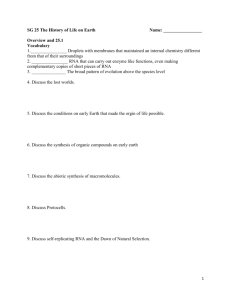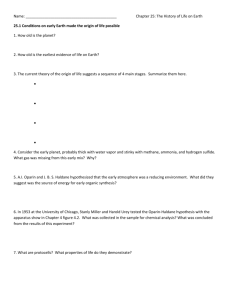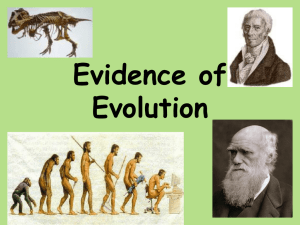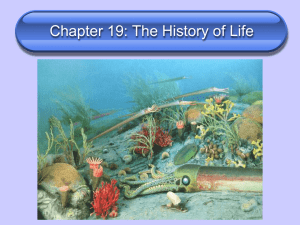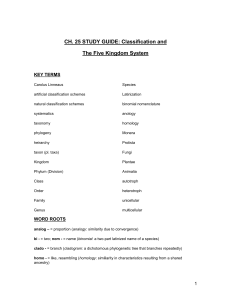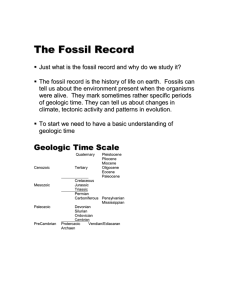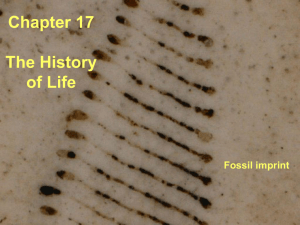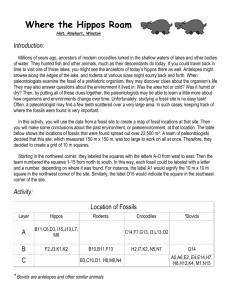Chapter 23 Notes: Population Genetics
advertisement
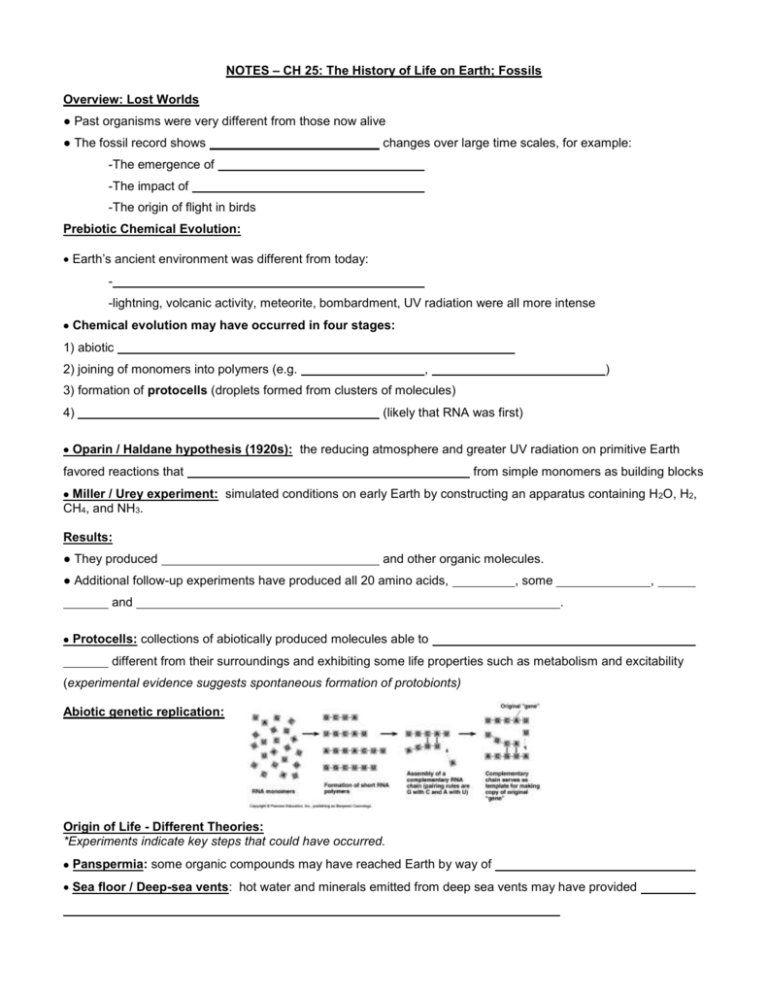
NOTES – CH 25: The History of Life on Earth; Fossils Overview: Lost Worlds ● Past organisms were very different from those now alive ● The fossil record shows changes over large time scales, for example: -The emergence of -The impact of -The origin of flight in birds Prebiotic Chemical Evolution: Earth’s ancient environment was different from today: -lightning, volcanic activity, meteorite, bombardment, UV radiation were all more intense Chemical evolution may have occurred in four stages: 1) abiotic 2) joining of monomers into polymers (e.g. , ) 3) formation of protocells (droplets formed from clusters of molecules) 4) (likely that RNA was first) Oparin / Haldane hypothesis (1920s): the reducing atmosphere and greater UV radiation on primitive Earth favored reactions that from simple monomers as building blocks Miller / Urey experiment: simulated conditions on early Earth by constructing an apparatus containing H 2O, H2, CH4, and NH3. Results: ● They produced and other organic molecules. ● Additional follow-up experiments have produced all 20 amino acids, and , some , . Protocells: collections of abiotically produced molecules able to different from their surroundings and exhibiting some life properties such as metabolism and excitability (experimental evidence suggests spontaneous formation of protobionts) Abiotic genetic replication: Origin of Life - Different Theories: *Experiments indicate key steps that could have occurred. Panspermia: some organic compounds may have reached Earth by way of Sea floor / Deep-sea vents: hot water and minerals emitted from deep sea vents may have provided Simpler hereditary systems (self-replicating molecules) may have preceded nucleic acid genes. Phylogeny: ● Systematics: the study of biological diversity in an evolutionary context ● The fossil record: , within layers, or strata, of sedimentary rock ● Paleontologists: ● A FOSSIL is the -bone of an organism or the print of a shell in a rock -burrow or tunnel left by an ancient worm -most common fossils: . The fossil record ● Sedimentary rock: rock formed from Methods for Dating Fossils: ● RELATIVE DATING: used to establish the geologic time scale; ● ABSOLUTE DATING: radiometric dating; determine using half-lives of radioactive isotopes Relative Dating: ● What is an INDEX FOSSIL? fossil used to must be easily recognized and must have existed for a short period BUT over wide geographical area. Radiometric Dating: ● Calculating the based on the amount of remaining radioactive isotopes it contains. Isotope = atom of an element that has a number of neutrons different from that of other atoms of the same element ● Certain naturally occurring elements / isotopes are radioactive, and they decay (break down) at predictable rates ● An isotope (the “parent”) loses particles from its nucleus to form a isotope of the new element (the “daughter”) ● The rate of decay is expressed in a “half-life” Half life = the amount of time it takes for To determine the age of a fossil: 1) compare the amount of the “parent” isotope to the amount of the “daughter” element 2) knowing the half-life, do the math to calculate the age! Example: Carbon 14 ● Used to date material that was once alive ● C-14 is in all plants and animals (C-12 is too, but it does NOT decay!) ● When an organism dies, the amount of C-14 decreases because it is being converted back to N-14 by radioactive decay ● By measuring the amount of C-14 compared to N-14, the time of death can be calculated ● C-14 has a half life of 5,730 years ● Since the half life is considered short, it can only date organisms that have died within the past 70,000 years How is the decay rate of a radioactive substance expressed? Equation: A = Ao x (1/2)n A = Ao = n= (**to find n, calculate t/T, where t = time, and T = half-life, in the same time units as t), so you can rewrite the above equation as: A = Ao x (1/2)t/T ½ Life Example #1: ● Nitrogen-13 decays to carbon-13 with t1/2 = 10 minutes. Assume a starting mass of 2.00 g of N-13. A) How long is three half-lives? B) How many grams of the isotope will still be present at the end of three half-lives? ½ Life Example #2: ● Mn-56 has a half-life of 2.6 hr. What is the mass of Mn-56 in a 1.0 mg sample of the isotope at the end of 10.4 hr? ½ Life Example #3: ● Strontium-90 has a half-life of 29 years. What is the mass of strontium-90 in a 5.0 g sample of the isotope at the end of 87 years? *The history of living organisms and the history of Earth are inextricably linked: Formation and subsequent affected biotic diversity BIOGEOGRAPHY: the study of the ● Formation of Pangaea - 250 m.y.a. (Permian extinction) ● Break-up of Pangaea – 180 m.y.a. (led to extreme cases of geographic isolation!) EX: ! Apparent continental drift results from Plate Tectonics: ● At three points in time, the land masses of Earth have formed a : 1.1 billion, 600 million, and 250 million years ago ● According to the theory of plate tectonics, Earth’s crust is composed of plates floating on Earth’s mantle ● Tectonic plates move slowly through the process of ● Oceanic and continental plates can , ● Interactions between plates cause the formation of , or slide past each other and , and Consequences of Continental Drift: ● Formation of the supercontinent Pangaea about 250 million years ago had many effects -A deepening of ocean basins -A -A colder and drier climate inland The first photosynthetic organisms and altered Earth’s atmosphere Members of Homo sapiens have changed the land, water, and air on a scale and at a rate ! History of Life on Earth: ● Life on Earth originated between 3.5 and 4.0 billion years ago ● Because of the relatively simple structure of prokaryotes, it is assumed that the *this is supported by fossil evidence(spherical & filamentous prokaryotes recovered from 3.5 billion year old stromatolites in Australia and Africa) The First Single-Celled Organisms ● The oldest known fossils are , rocks formed by the accumulation of sedimentary layers on bacterial mats ● Stromatolites date back 3.5 billion years ago ● Prokaryotes were Earth’s sole inhabitants from 3.5 to about 2.1 billion years ago Major Episodes in the History of Life: ● : 3.5 - 4.0 billion years ago ● : 2.5 - 2.7 billion years ago Photosynthesis and the Oxygen Revolution ● Most atmospheric oxygen (O2) is of ● This “oxygen revolution” from 2.7 to 2.3 billion years ago caused the extinction of many prokaryotic groups ● Some groups survived and adapted using cellular respiration to harvest energy Major Episodes in the History of Life: (cont.) : 2 billion years ago The First Eukaryotes ● The oldest fossils of eukaryotic cells date back 2.1 billion years ● Eukaryotic cells have a nuclear envelope, mitochondria, endoplasmic reticulum, and a cytoskeleton ● The proposes that mitochondria and plastids (chloroplasts and related organelles) were formerly ● An endosymbiont is a Endosymbiont Theory: ● The prokaryotic ancestors of mitochondria and plastids probably gained entry to the host cell as undigested prey or internal parasites ● In the process of becoming more interdependent, the host and endosymbionts would have become a single organism ● Serial endosymbiosis supposes that mitochondria evolved before plastids through a sequence of endosymbiotic events ● Key evidence supporting an endosymbiotic origin of mitochondria and plastids: -Inner membranes are similar to -Division is similar in these organelles and some prokaryotes -These organelles -Their ribosomes are more similar to prokaryotic than eukaryotic ribosomes The Origin of Multicellularity ● The evolution of eukaryotic cells allowed for a greater range of unicellular forms ● A second wave of diversification occurred when multicellularity evolved and gave rise to algae, plants, fungi, and animals Major Episodes in the History of Life: (cont.) ● plants evolved ● from different groups of ● ( ● first ): 550 - 700 million years ago by plants and fungi: 475 - 500 million years ago plants forms of life and created new opportunities for all The Cambrian Explosion ● The Cambrian explosion refers to the sudden appearance of fossils resembling modern animal phyla in the Cambrian period (535 to 525 million years ago) ● A few animal phyla appear even earlier: sponges, cnidarians, and molluscs ● The Cambrian explosion provides the first evidence of The “Big Five” Mass Extinction Events ● In each of the five mass extinction events, more than 50% of Earth’s species became extinct Mass extinctions: ● Permian (250 m.y.a.): 90% of marine animals; Pangaea merges ● Cretaceous (65 m.y.a.): death of dinosaurs, 50% of marine species; low angle comet Consequences of Mass Extinctions ● Mass extinction can alter ecological communities and the niches available to organisms ● It can take from 5 to 100 million years for diversity to recover following a mass extinction ● The percentage of marine organisms that were predators increased after the Permian and Cretaceous mass extinctions ● Mass extinction can pave the way for Adaptive Radiations ● Adaptive radiation is the evolution of diversely adapted species ● Adaptive radiations may follow -Mass extinctions -The evolution of novel characteristics -The colonization of new regions Worldwide Adaptive Radiations ● Mammals underwent an adaptive radiation ● The disappearance of dinosaurs (except birds) allowed for the expansion of mammals in diversity and size ● Other notable radiations include photosynthetic prokaryotes, large predators in the Cambrian, land plants, insects, and tetrapods Regional Adaptive Radiations ● Adaptive radiations can occur when organisms ● The Hawaiian Islands are one of the world’s great showcases of adaptive radiation Evolution is not goal oriented: ● Evolution is like tinkering — it is a process in which new forms arise by the Evolutionary Novelties ● Most novel biological structures evolve in ● Complex eyes have evolved from simple photosensitive cells independently many times ● Natural selection in the context of its current utility
